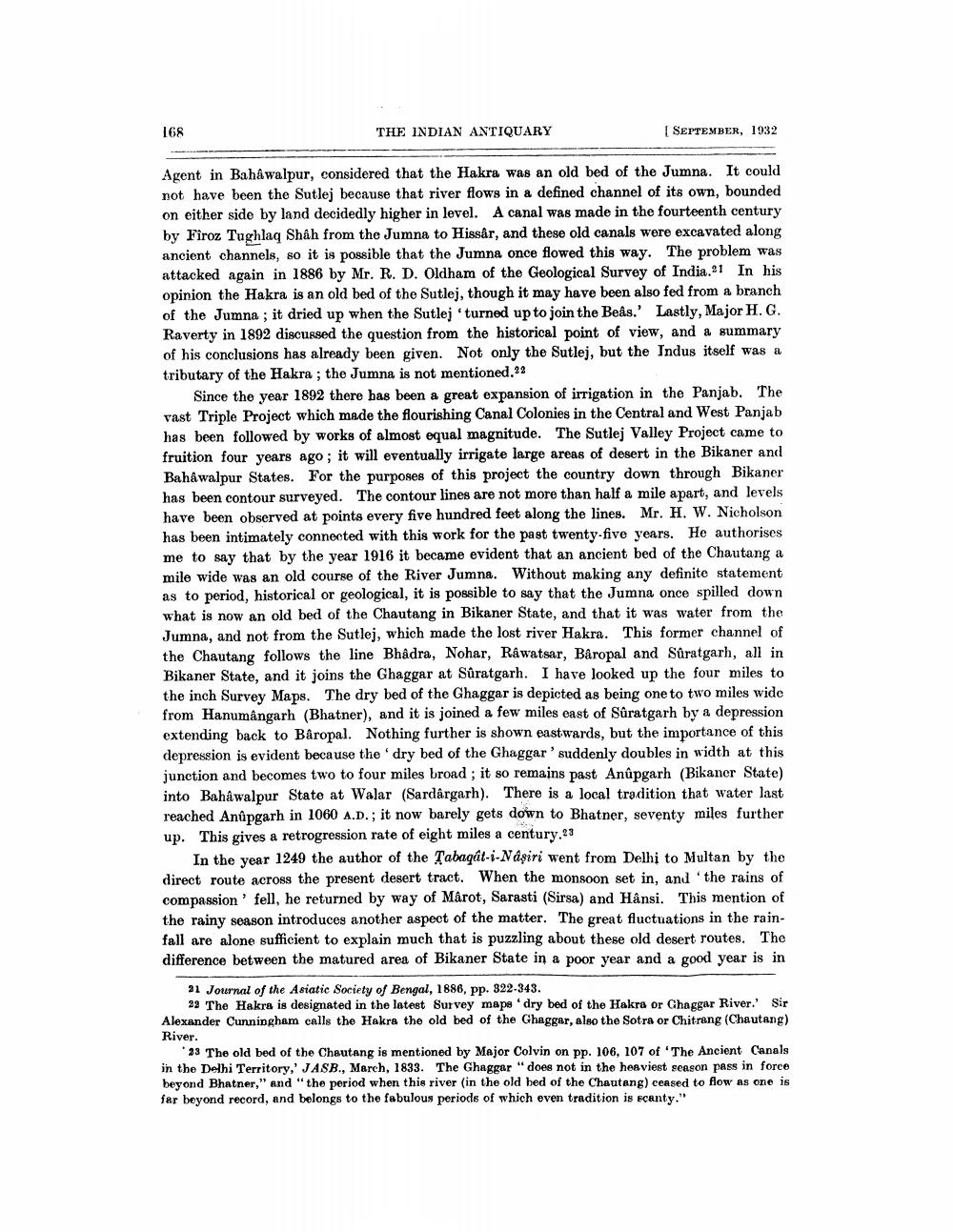________________
168
THE INDIAN ANTIQUARY
[ SEPTEMBER, 1932
Agent in Bahawalpur, considered that the Hakra was an old bed of the Jumna. It could not have been the Sutlej because that river flows in a defined channel of its own, bounded on either side by land decidedly higher in level. A canal was made in the fourteenth century by Firoz Tughlaq Shah from the Jumna to Hissâr, and these old canals were excavated along ancient channels, so it is possible that the Jumna once flowed this way. The problem was attacked again in 1886 by Mr. R. D. Oldham of the Geological Survey of India.91 In his opinion the Hakra is an old bed of the Sutlej, though it may have been also fed from a branch of the Jumna; it dried up when the Sutlej 'turned up to join the Beas. Lastly, Major H. G. Raverty in 1892 discussed the question from the historical point of view, and a summary of his conclusions has already been given. Not only the Sutlej, but the Indus itself was a tributary of the Hakra; the Jumna is not mentioned. 22
Since the year 1892 there has been a great expansion of irrigation in the Panjab. The vast Triple Project which made the flourishing Canal Colonies in the Central and West Panjab has been followed by works of almost equal magnitude. The Sutlej Valley Project came to fruition four years ago; it will eventually irrigate large areas of desert in the Bikaner and Bahawalpur States. For the purposes of this project the country down through Bikaner has been contour surveyed. The contour lines are not more than half a mile apart, and levels have been observed at points every five hundred feet along the lines. Mr. H. W. Nicholson has been intimately connected with this work for the past twenty-five years. He authorises me to say that by the year 1916 it became evident that an ancient bed of the Chautang a mile wide was an old course of the River Jumna. Without making any definite statement as to period, historical or geological, it is possible to say that the Jumna once spilled down what is now an old bed of the Chautang in Bikaner State, and that it was water from the Jumna, and not from the Sutlej, which made the lost river Hakra. This former channel of the Chautang follows the line Bhadra, Nohar, Rawatsar, Båropal and Suratgarh, all in Bikaner State, and it joins the Ghaggar at Suratgarh. I have looked up the four miles to the inch Survey Maps. The dry bed of the Ghaggar is depicted as being one to two miles wide from Hanumangarh (Bhatner), and it is joined a few miles east of Sûratgarh by a depression extending back to Båropal. Nothing further is shown eastwards, but the importance of this depression is evident because the dry bed of the Ghaggar' suddenly doubles in width at this junction and becomes two to four miles broad; it so remains past Anûpgarh (Bikaner State) into Bahawalpur State at Walar (Sardârgarh). There is a local tradition that water last reached Anûpgarh in 1060 A.D.; it now barely gets down to Bhatner, seventy miles further up. This gives a retrogression rate of eight miles a century.23
In the year 1249 the author of the Tabaqát-i-Nasiri went from Delhi to Multan by the direct route across the present desert tract. When the monsoon set in, and the rains of compassion' fell, he returned by way of Marot, Sarasti (Sirsa) and Hânsi. This mention of the rainy season introduces another aspect of the matter. The great fluctuations in the rainfall are alone sufficient to explain much that is puzzling about these old desert routes. The difference between the matured area of Bikaner State in a poor year and a good year is in
91 Journal of the Asiatic Society of Bengal, 1886, pp. 322-343.
22 The Hakra is designated in the latest Survey mapedry bed of the Hakra or Chaggar River.' Sir Alexander Cunningham calls the Hakra the old bed of the Ghaggar, also the Sotra or Chitrang (Chautang) River.
33 The old bod of the Chautang is mentioned by Major Colvin on pp. 106, 107 of 'The Ancient Canals in the Delhi Territory,' JASB., March, 1833. The Ghaggar "does not in the heaviest season pass in force beyond Bhatner," and "the period when this river (in the old bed of the Chautang) ceased to flow as one is far beyond record, and belongs to the fabulous periods of which even tradition is eçanty."




